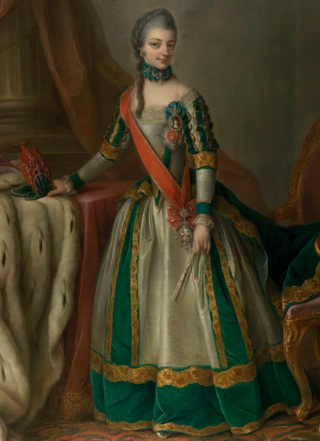
The Duchy of Mecklenburg-Strelitz was a duchy in Northern Germany consisting of the eastern fifth of the historic Mecklenburg region, roughly corresponding with the present-day Mecklenburg-Strelitz district, and the western Principality of Ratzeburg exclave, which lay mostly in the west of the modern Nordwestmecklenburg district. At the time of its establishment, the main part of the duchy bordered on the territory of Swedish Pomerania in the north and of Brandenburg in the south; Ratzeburg bordered Saxe-Lauenburg and the Free City of Lübeck.

Neustrelitz is a town in the Mecklenburgische Seenplatte district in the state of Mecklenburg-Vorpommern, Germany. It is situated on the shore of the Zierker See in the Mecklenburg Lake District. From 1738 until 1918 it was the capital of the Duchy of Mecklenburg-Strelitz. From 1994 until 2011 it was the capital of the district of Mecklenburg-Strelitz.

The Duchy of Mecklenburg-Schwerin was a duchy in northern Germany created in 1701, when Frederick William and Adolphus Frederick II divided the Duchy of Mecklenburg between Schwerin and Strelitz. Ruled by the successors of the Nikloting House of Mecklenburg, Mecklenburg-Schwerin remained a state of the Holy Roman Empire along the Baltic Sea littoral between Holstein-Glückstadt and the Duchy of Pomerania.

Adolphus Frederick II, Duke of Mecklenburg, was the first Duke of the Mecklenburg-Strelitz, reigning from 1701 until his death. Mecklenburg-Strelitz was a part of the Holy Roman Empire.

The Grand Duchy of Mecklenburg-Strelitz was a territory in Northern Germany, held by the younger line of the House of Mecklenburg residing in Neustrelitz. Like the neighbouring Grand Duchy of Mecklenburg-Schwerin, it was a sovereign member state of the German Confederation and became a federated state of the North German Confederation and finally of the German Empire upon the unification in 1871. After World War I and the German Revolution of 1918–19 it was succeeded by the Free State of Mecklenburg-Strelitz.

Adolphus Frederick VI was the last reigning grand duke of Mecklenburg-Strelitz.

Adolphus Frederick V was reigning grand duke of Mecklenburg-Strelitz from 1904 to 1914.

Borwin, Duke of Mecklenburg has been the head of the House of Mecklenburg-Strelitz since 1996 and of the entire House of Mecklenburg since 2001. The death of Friedrich Franz, Hereditary Grand Duke of Mecklenburg-Schwerin – his godfather – the last male member of the House of Mecklenburg-Schwerin on 31 July 2001 made Strelitz the only remaining line of the House of Mecklenburg, which ruled in Mecklenburg until 1918.

Adolphus Frederick III was a Duke of Mecklenburg-Strelitz. He founded the town of Neustrelitz as the capital of Mecklenburg-Strelit to replace the old capital which had burnt down.

Mecklenburg-Güstrow was a state of the Holy Roman Empire in Northern Germany, that existed on three occasions ruled by the House of Mecklenburg at Güstrow.

The Staatliches Museum Schwerin is an art gallery and museum in Schwerin in Germany. It was established by Frederick Francis II, Grand Duke of Mecklenburg-Schwerin in 1882 its historicist Haupthaus as the Staatsgalerie next to the Staatstheater. Its other locations are opposite the Schweriner Schloss and in the former residences at Schloss Güstrow and Schloss Ludwigslust.

Prince Ulrik of Denmark was a son of King Christian IV of Denmark and Norway and his consort Queen Anne Catherine of Brandenburg. As the fourth-born son, he bore the merely titular rank of Duke of Holstein and Schleswig, Stormarn and Ditmarsh; however, he had no share in the royal-ducal condominial rule of Holstein and Schleswig, wielded by the heads of the houses of Oldenburg (royal) and its cadet branch Holstein-Gottorp (ducal). In 1624 Ulrik was appointed administrator of the Prince-Bishopric of Schwerin as Ulrich III. However, in 1628 Wallenstein's conquest of the prince-bishopric de facto deposed him. His father had to renounce all his family claims to prince-bishoprics in 1629. When in 1631 Swedish forces reconquered the prince-bishopric Ulrik failed to reascend as administrator.
Heinrich Pommerencke (1821–1873) was a successful portrait painter of Mecklenburg-Schwerin.
Events in the year 1918 in Germany.

The House Order of the Wendish Crown is a dynastic order that was jointly instituted on 12 May 1864 by Grand Duke Friedrich Franz II of Mecklenburg-Schwerin and Grand Duke Friedrich Wilhelm of Mecklenburg-Strelitz. It is the oldest and most senior order of the House of Mecklenburg.

The Order of the Griffon was a State Order of the Grand Duchy of Mecklenburg-Schwerin. Established on 15 September 1884, it was created to honour benevolence and outstanding service to the public. In August 1904, the Order of the Griffon was extended to citizens of the Grand Duchy of Mecklenburg-Strelitz, with the rulers of the two grand duchies serving jointly as the Grand Masters of the order.

The House Order of Henry the Lion In German: Hausorden Heinrichs des Löwen, was the House Order of the Duchy of Brunswick. It was instituted by William VIII, Duke of Brunswick on 25 April 1834. The ribbon of the Order was red with yellow edges. It had five grades: Grand Cross, Grand Commander with Sash, Commander, Knight 1st Class, Knight 2nd Class, plus Medal of Merit for Science and Arts, the Cross of Merit and the Medal of Honour. The Order was named in honour of Henry the Lion, who remains a popular figure to this day.

Georg David Matthieu was a German engraver and portrait painter in the Rococo style who worked as court painter for the Duke of Mecklenburg.

Duchess Christiane Sophie Albertine of Mecklenburg-Strelitz was member of the House of Mecklenburg and a granddaughter of Duke Adolphus Frederick II. She was the eldest sister of Charlotte, Queen of the United Kingdom; Adolphus Frederick IV, Duke of Mecklenburg-Strelitz; and Charles II, Grand Duke of Mecklenburg-Strelitz.

















